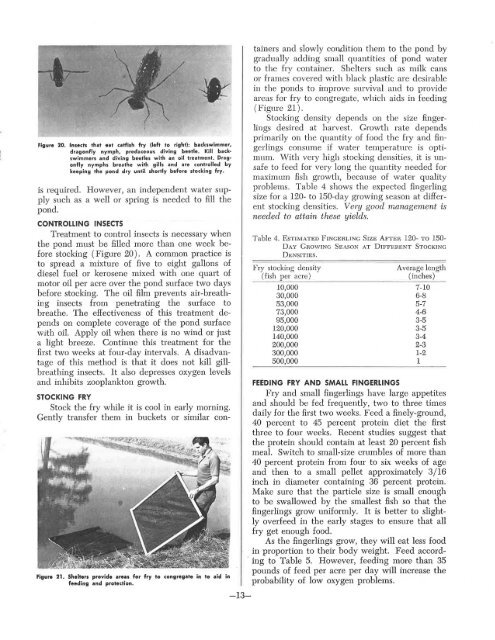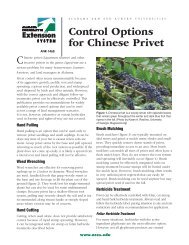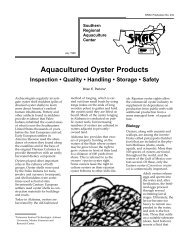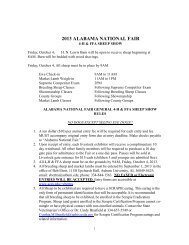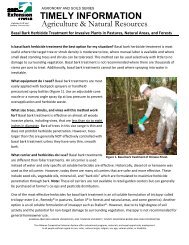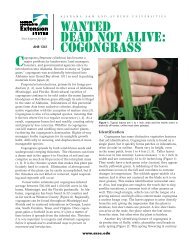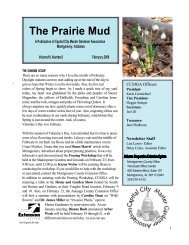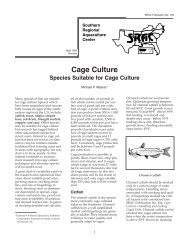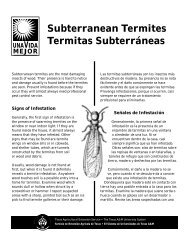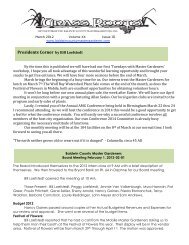PRODUCING - Alabama Cooperative Extension System
PRODUCING - Alabama Cooperative Extension System
PRODUCING - Alabama Cooperative Extension System
You also want an ePaper? Increase the reach of your titles
YUMPU automatically turns print PDFs into web optimized ePapers that Google loves.
Figure 20. Insects that eat catfish fry (left to right): backswimmer,<br />
dragonfly nymph, predaceous diving beetle. Kill back·<br />
swimmers and diving beetles with an oil treatment. Drag·<br />
onfly nymphs breathe with gills and are controlled by<br />
keeping the pond dry until shortly before stocking fry.<br />
is required. However, an independent water supply<br />
such as a well or spring is needed to fill the<br />
pond.<br />
CONTROLLING INSECTS<br />
Treatment to control insects is necessary when<br />
the pond must be filled more than one week before<br />
stocking ( Figure 20) . A common practice is<br />
to spread a mixture of five to eight gallons of<br />
diesel fuel or kerosene mixed with one quart of<br />
motor oil per acre over the pond surface two days<br />
before stocking. The oil film prevents air-breathing<br />
insects from penetrating the surface to<br />
breathe. The effectiveness of this treatment depends<br />
on complete coverage of the pond surface<br />
with oil. Apply oil when there is no wind or just<br />
a light breeze. Continue this treatment for the<br />
first two weeks at four-day intervals. A disadvantage<br />
of this method is that it does not kill gillbreathing<br />
insects. It also depresses oxygen levels<br />
and inhibits zooplankton growth.<br />
STOCKING FRY<br />
Stock the fry while it is cool in early morning.<br />
Gently transfer them in buckets or similar con-<br />
Figure 21. Shelters provide areas for fry to congregate in to aid in<br />
feeding and protection.<br />
-13-<br />
tainers and slowly condition them to the pond by<br />
gradually adding small quantities of pond water<br />
to the fry container. Shelters such as milk cans<br />
or frames covered with black plastic are desirable<br />
in the ponds to improve survival and to provide<br />
areas for fry to congregate, which aids in feeding<br />
(Figure 21).<br />
Stocking density depends on the size fingerlings<br />
desired at harvest. Growth rate depends<br />
primarily on the quantity of food the fry and fingerlings<br />
consume if water temperature is optimum.<br />
With very high stocking densities, it is unsafe<br />
to feed for very long the quantity needed for<br />
maximum fish growth, because of water quality<br />
problems. Table 4 shows the expected fingerling<br />
size for a 120- to 150-day growing season at different<br />
stocking densities. V eTy good management is<br />
needed to attain these yields.<br />
Table 4. EsTIMATED FINGERLING SizE AFTER 120- TO 150-<br />
DAY GROWING SEASON AT DIFFERENT STOCKING<br />
DENSITIES.<br />
Fry stocking density<br />
(fish per acre)<br />
10,000<br />
30,000<br />
53,000<br />
73,000<br />
95,000<br />
120,000<br />
140,000<br />
200,000<br />
300,000<br />
500,000<br />
Average length<br />
(inches)<br />
7-10<br />
6-8<br />
5-7<br />
4-6<br />
3-5<br />
3-5<br />
3-4<br />
2-3<br />
1-2<br />
1<br />
FEEDING FRY AND SMALL FINGERLINGS<br />
Fry and small fingerlings have large appetites<br />
and should be fed frequently, two to three times<br />
daily for the first two weeks. Feed a finely-ground,<br />
40 percent to 45 percent protein diet the first<br />
three to four weeks. Recent studies suggest that<br />
the protein should contain at least 20 percent fish<br />
meal. Switch to small-size crumbles of more than<br />
40 percent protein from four to six weeks of age<br />
and then to a small pellet approximately 3/16<br />
inch in diameter containing 36 percent protein.<br />
Make sure that the particle size is small enough<br />
to be swallowed by the smallest fish so that the<br />
fingerlings grow uniformly. It is better to slightly<br />
overfeed in the early stages to ensure that all<br />
fry get enough food.<br />
As the fingerlings grow, they will eat less food<br />
in proportion to their body weight. Feed according<br />
to Table 5. However, feeding more than 35<br />
pounds of feed per acre per day will increase the<br />
probability of low oxygen problems.


